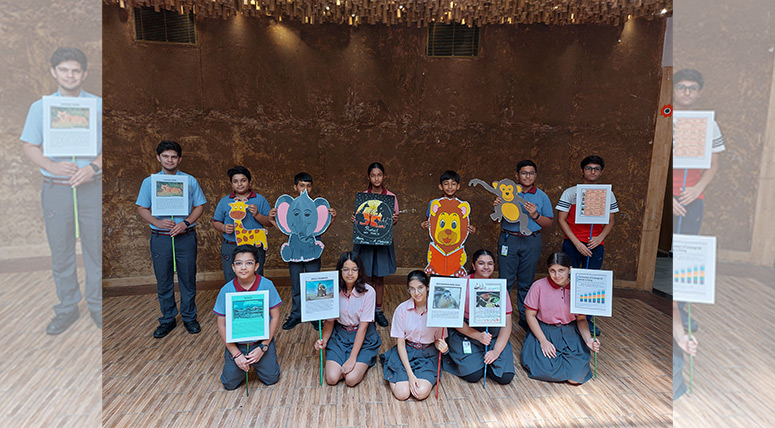The Trauma of Being a Victim!
MRIS 14, Faridabad wishes a Very Happy Diwali to All and requests to be empathetic towards animals during celebrations!
Hunting for Sports?
Trophy Hunting is banned in India! In this post of MRIS VIBES by Dr. Shalini Bindra, Senior Vice-Principal, MRIS 14, Faridabad, We understand students and people are expected to empathize with animal-torture and be aware of the consequences of Recreational Trophy Hunting which is still legal in some countries. In India, post-independence, hunting was banned by the Government under the Wildlife (Protection) Act, 1972, except for specified purposes such as for self-defense, to prevent crop damage, to counter vermin species and for scientific or educational reasons. We do not consider Trophy Hunting healthy for global growth.
I hunt for pleasure, they say.
I hunt because it makes me feel good, they say.
I hunt because it is an ancestral custom, they say.
For indulging in Sport Hunting, you may have various reasons for justifying this act but the bottom-line is clear, it isn’t necessary, and it is no fun for animals.
Let us see the Historical Backdrop of Hunting as a Sport: Dating back to the Middle-Ages, hunting as a sport began in Europe as a leisure activity amongst wealthy people. The nobility was allowed to hunt hares, harts, wolves, and boars, while peasants were usually only allowed to hunt ‘vermin’ such as badgers and otters. Poaching was a popular activity throughout this period. After and during the 18th century, hunting was understood to be an image of war, rather an indulgence tied to colonialism. The violence involved gave the upper ranks of society a privileged stance and it was considered to be righteous.
A Socially Acceptable Sport – Trophy Hunting–“I ask people why they have deer heads on their walls. They always say because it’s such a beautiful animal. There you go. I think my mother is attractive, but I have photographs of her. ~ Ellen DeGeneres
People usually defined trophy hunting as a sport when some prize money was/is linked to victory in a particular competition. Numerous wildlife killing contests violate all ethics. The dead bodies of animals are disposed of mercilessly. These predator hunting contests are especially controversial. In most cases, the animal’s life is at stake while the hunters escape, with no risk to their lives.

Sport Hunting – A cruel and mindless venture! How are ‘achievements’ decided by hunters’? For them, taking the life of an animal is an achievement. For them, animals are like simple play toys which are to be squashed and thrown. It seems these people believe that the purpose of everything in the world is to cater to human life. This is a very limited and cramped view where human beings profess themselves as the sole master of the universe.
One of the most ridiculous explanations offered by trophy hunters is that the victim was given a fair chance to escape and yet the killing happened. It is quite clear and understandable that the status of social and economic class throughout history has been attached to trophy hunting while they claim themselves educated and civilized, though!
Laughing and shooting videos, while a victim is being harangued, is by no means ‘fun’. The idea and definition of ‘fun’ need to be put in the right perspective. Animals, and birds, deserve better treatment than being subjected to situations where they are not merely at the whims of some human beings. Moreover, when the hunter’s shot is missed, the injuries inflicted upon the animals lead to extreme levels of sufferings as mentioned earlier.

Nature needs an equilibrium that is disrupted by mindless hunting. The extinction of one species leads to the multiplicity of another form which can wreak havoc on the ecological balance and thereby pose a serious threat to the human race as well. In India hunting is legally banned but still small and stray animals are tortured for fun sake. On foreign locales where hunting is legal, the camp sites organized for sport hunting are harmful to the environment with a remarkable CO2 emission from the vehicles involved in this mad game.
Sport hunting is a risky affair. Many times, it leads to the accidental hurting of teammates. In some cases, it might even result in the death of humans involved. This is the result of carelessness, lack of proper experience, and impulsive actions of the hands holding the gun. Thus, hunting without caring for proper rules can be a fatal, uncertain, and unfortunate state of affairs.
As hunters generally aim to kill the adult members of an animal population, their offspring mostly face the torture in finding food. Surviving in extreme weather conditions becomes a horrendous task for them. Therefore, hunting can harm the sustenance of several species. In addition to this, the practice of taking exotic animals to non-native environments for hunters to kill is hugely problematic because if they escape, they might pose a serious threat to the native wildlife and ecosystems.
Moreover, adverse effects on population genetics are also seen: As hunters strive to kill the largest and the most robust of the species’ population which, in turn, cause major disruptions in the wildlife. For example, in Canada, this sport has caused the size of the bighorn sheep’s most prized possession –its horn to fall by 25 percent in the last 40 years. As per an article in the ‘Nature Publication’, the effects of hunting on the populations’ genetics are probably deeper than what meets the eye.
Let me bring out some very important points. According to the information worldwide, annual death toll due to Sport Hunting in the U.S. includes 42 million mourning doves, 30 million squirrels, 28 million quail, 25 million rabbits, 20 million pheasants, 14 million ducks, 6 million deer, and thousands of geese, bears, moose, elk, antelope, swans, cougars, turkeys, wolves, foxes, coyotes, bobcats, boars, and other woodland inhabitants.
Sourced from the Business Standard, the following information about the situation in India is definitely more than alarming.
- India lost 329 tigers in the last three years due to poaching, natural and unnatural causes.
- As many as 307 elephants have died in this period due to poaching, electrocution, poisoning and train accidents.
- According to the data presented by Union Minister of State for Environment Ashwini Kumar Choubey in Lok Sabha, 96 tigers died in 2019, 106 in 2020 and 127 in 2021.
- 68 tiger deaths were attributed to natural causes, five to unnatural causes, 29 to poaching and 30 to ‘seizure’. A total of 197 tiger deaths are under scrutiny.
- However, the number of poaching cases has reduced over the years — from 17 in 2019 to four in 2021.
- 125 people have been killed in tiger attacks during this period, including 61 in Maharashtra and 25 in Uttar Pradesh.
- 222 elephants have died due to electrocution in the last three years, with Odisha, Tamil Nadu and Assam reporting 41, 34 and 33 such deaths, respectively.
- 29 elephants have died due to poaching, including 12 in Meghalaya and seven in Odisha, while 11 elephants have died due to poisoning, including nine in Assam during the period.
What is PETA?
People for the Ethical Treatment of Animals (PETA), with over 9 million members globally, are the largest animal rights organization in the world. It explicitly delineates the various problems associated with sport hunting. The organization works through public education, legislation, animal rescue, special events, celebrity involvement, and protest campaigns.
As an example, we can take the case of the spread of chronic wasting disease (CWD) among deer and elk in the United States. This is primarily a neurological illness that is caused by the transfer of captive-bred deer and elk between states. This disease is highly fatal and can be compared to the widely prevalent mad cow disease. The U.S. Department of Agriculture (USDA) has subsequently given state wildlife agencies millions of dollars to ‘manage’ deer and elk populations. While the USDA and the Centers for Disease Control and Prevention claim that CWD has no relationship to any similar diseases that affect humans or farmed animals, the slaughter of deer and elk continues.
Now let us brain storm, how can we as schools contribute? Schools are the incubation center to make a child life ready, educated, and sensitized. The core and ethics of a person are well seeded in school and the formative years of a child. The purpose of education should enable one to meet the purpose of life. Therefore, School education encompasses a holistic approach to moral values. Students today are no longer confined to theoretical knowledge but are well aware of the challenges facing the world. Animal extinction and its causes are all-pervasive. Through summer projects, role plays, talk shows, and debates, students are made to understand the purport of ill effects of hunting, even if it is a sport.
As a part of the Annual Projects, Manav Rachna International School students have raised concerns over this pertinent issue. The ‘Life on Land’ project recently undertaken by the students of MRIS-14 aimed to do just that. Emotions of empathy, compassion, and love are the basic ingredients required to sustain life on earth. Through POP talks and initiatives related to environmental protection, the future-ready generation has been sensitized to the serious issue of preserving endangered species.
Also, Special Assemblies of schools themed around special days devoted to the environment are held time and again to make the students aware of the role they can play in safeguarding the world. Themes like ‘Wildlife Conservation Day’ and ‘World Animal Day’ which are informative and crucial in Sensitizing the youth towards these pertinent issues are showcased through the assemblies.

Next, let’s see what the govt. is doing to save the animals from torture.
With the expansion of industries, and global movement, many species of animals have been declared extinct with several others on the verge of it. The Central Government has undertaken significant projects and put into practice policies that are commendable and praiseworthy. Some of these are:
- A new component known as ‘Recovery of Endangered Species’ has been included in Integrated Development of Wildlife Habitats which is a centrally sponsored scheme including 16 species that have been identified for recovery.
- National Biological Diversity Act (NBA), 2002 was articulated in order to ensure the protection of threatened species and their habitats. Under Section 38 of the NBA, 2002 the species which are on the verge of extinction or likely to become extinct in near future as threatened species, are notified.
- The Indian government has also taken up some important wildlife protection projects such as the Project Tiger, Project Elephant, Crocodile Conservation Project, UNDP Sea Turtle Project, Project Rhino, the Great Indian Bustard, and many other eco-development projects.
Let’s come to another important point that, how Global warming and Over Hunting (in countries, where this sport is allowed) are related. So let us understand, what is overhunting? The act of excessive hunting of animals, more than their populations can supply, is overhunting. A recent article that I read about overhunting left me thinking about human carelessness. Relentless chasing of animals for personal and economic gains or simply for a sense of pseudo power will have far-reaching consequences till human beings as a species would become extinct. Have we ever thought about it?
As per a paper published in Proceedings of the National Academy of Sciences, the decline in seed-dispersing species in the Amazon rainforests on account of overhunting could result in a significant loss of carbon stock on the ground. Peres, one of the authors of the PNAS paper, stated that hunting larger mammals in the Amazon might lead to major biomass loss, ranging from 2.5 to 37.8 percent. After researching a lot on this topic, I came to this point that, that Sport hunting results in the death of hundreds of thousands of wild mammals, including endangered or threatened species each year.
Trophy hunters prefer to kill the largest, strongest animals which also threaten the existence of various ecosystems. This is the time to take cognizance of the gravity of this problem in totality which would further help us, as a society, to rise above the archetype of an ignorant and power-driven construct. The question that finally arises is – Should we treat killing animals as a sport? It is a cruel act and speaks about the character of those people who, simply kill for the sake of entertainment. No argument can justify the pleasure of seeing a corpse above the fireplace.
In the context of the aforementioned arguments, facts and figures, it is imperative to raise public awareness through various civil society led as well as legal initiatives. According to my belief-Right Education is the answer!

Author: Dr. Shalini Bindra, Vice Principal, Senior Wing, MRIS 14, Faridabad





